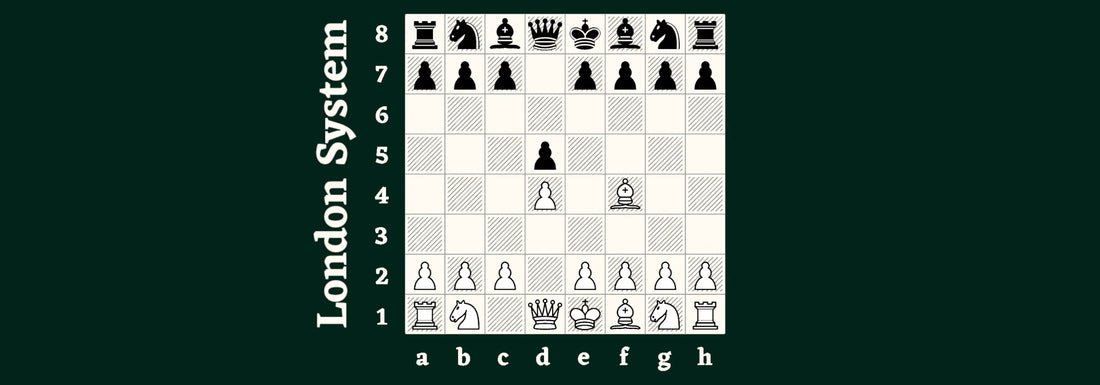
Chess Opening: The London System
Share
The London System is a very popular opening that is used by club players of all levels. In contrast to many other openings, the early development of the chess pieces does not concentrate on the knight first, but attempts to position the bishop on f4 as early as the second move. The London System is one of the easier openings to learn and is therefore also suitable for beginners. Due to its robust structure, the London System offers protection against many of Black's openings and often ends in a draw - which is why it is sometimes described as monotonous or boring.
The opening itself has long been known in the history of chess. It first appeared in literature between 1500 and 1505 in the " Göttinger Handschriften", an early treatise on the game of chess which, despite its name, originated in Nancy, France. In 1752, the physician Friedrich Boerner gave the book to the Göttingen State and University Library, which cemented its name as the "Göttinger Handschrift". The author of the work is most likely the Spaniard Luis Ramírez Lucena, whose writings are very similar to the contents of the book.

The main variation of the opening proceeds via the following moves:
1.d4 d5 2. ♗f4...
White actively positions his bishop on f4. The e5-square is protected by the pawn on d4 and an attack via g5 would greatly weaken Black's kingside. To survive against the London system, Black must come up with a precise plan of attack, whereas White can take up a stable position and develop his pawns.
Strengths of the London System
The London System chess opening has many strengths that make it difficult for Black to gain the upper hand:
- Very solid Opening:
The London System offers White a high degree of security and Black only few attacking possibilities. Players who prefer a quiet and rather passive game will quickly find their feet with this opening.
- Little Theory Necessary:
The opening is quickly learned and requires little prior theoretical knowledge, as the early course of the game is always the same and only switches to tactical manoeuvres in the middlegame. There is therefore no need to memorise countless chess moves, making it easy for chess beginners to get started.
- Simple Development of the Chess Pieces:
The London system has few weak points and Black should find it difficult to set up threats in the early phase of the game. White therefore has plenty of freedom to develop his chess pieces and position himself right from the start.
- Often Underestimated by the Opponent:
The opening is known for maintaining White's advantage by countering most of Black's moves. If the opponent is not prepared for the London System, the probability of victory for White increases greatly.
Weaknesses of the London System
Even if the strengths clearly speak in favour of the chess opening, it also has its weaknesses, which Black will try to exploit:
- Only low Aggressiveness:
The London System is a very stable but also passive opening that focuses on the development of the chess pieces. Without an attacking plan, a quiet game develops, which does not necessarily turn out in White's favour later on.
- Little Flexibility in the Opening:
The moves in the opening phase offer little room for variation, as White must attack certain squares in the centre to suppress a counter-attack. The opening basically concentrates on moving straight into the middlegame.
- Tendency towards a Draw:
Due to its typical moves in the opening and the very solid position for White, the London System is notorious for maintaining a balanced exchange of blows throughout the course of the game. The result is a draw in many cases and the reputation of a rather boring chess opening.
- Preparation of the Opponent:
If the opponent is prepared for the opening, it is comparatively easy for him to gain an advantage against White. The reason for this is that White makes many standardised moves in the opening phase which are not necessarily strategically far-sighted. With the right preparation, Black would carry out this strategic groundwork in the opening phase and benefit from it later in the game.
Possible Courses of the London System
Standardised openings in the London System are rare, which is why preparation is difficult and many players are extremely reluctant to play against this opening. However, here are a few inspirations of how chess games could go:
Regular Course of the London System

Chess Moves:
1.d4 ♘f6 2.♗f4 d5 3.e3 c5 4.c3 ♘c6 5.♗d3 e6 6.♘f3...
The usual course of the London system is characterised by an advance of the d-pawn and a positioning of the bishop outside the pawn chain to give it more space. All subsequent moves protect other pawns and contribute to the development of a solid positional game. Black has few attacking options, but can anticipate all of White's moves and make preparations for a counterattack if White does not deviate from the London system. In the starting position above, Black can now move his bishop to d6. White can react in different ways. Capture the black bishop, retreat his own bishop to g3, develop his knight on d2 or castle on the kingside. Depending on which decisions are made, the middlegame and the transition to the players' individual tactics begins here.
The London System against the King's Indian Defence

Chess Moves:
1.d4 ♘f6 2.♗f4 g6 3.♘c3 ♗g7 4.e4 d6 5.h4...
If Black plays the King's Indian Defence, it is advisable for White to vary the London System early on in order to counter the black knight. In particular, the e4-square must be defended and, in the best case, an additional advance on e5 must be made in order to block the fianchetto. In the illustration, White has the options of either attacking on the e-file or even weakening the kingside with the h-pawn and making castling unattractive for Black. If the h-pawn is captured with the knight, it is even worth sacrificing the rook and integrating the queen in order to gain the upper hand on the kingside.
Rapport-Jobava System
Chess Moves:
1.d4 d5 2.♗f4 ♘f6 3.♘c3 c5 4.e3 e6 5.♘b5 ♘a6 6.a4...
The Rapport-Jobava Variation is characterised by an early shift to the queenside. After the typical moves into the centre and the active positioning of the bishop on f4, White attacks with his knight via b5. This is defended by the bishop on f1 and can even receive additional support from the a-pawn. White's skilful positioning allows him to build up a threat that can become dangerous for Black later on via the squares c7 and d6. Both squares are attacked by the knight on b5 and defended by the bishop on f4. In addition, White can use his advantage to develop his chess pieces first.
Conclusion
Despite its reputation as a boring chess opening, the London System is nevertheless very famous and offers players of all levels both opportunities and challenges. In particular, the low demands on theoretical knowledge make the opening interesting even for beginners and are compatible with the opening rule of harmonious development of the chess pieces. The fact that the London System often leads to draws should only be an argument against this chess opening for advanced players and only under certain conditions.
I hope that you have received a good introduction to the London System and that I have been able to give you a good overview. If you have any further questions, please write to me using my contact form. And if you are interested in chess pieces or chessboards in tournament format, please take a look at my product range.
I wish you lots of fun with the game, much success and rapid progress with your learning.
See you soon.
Stefan

